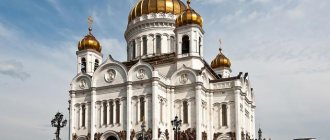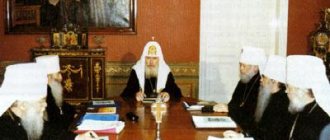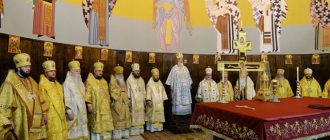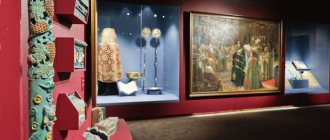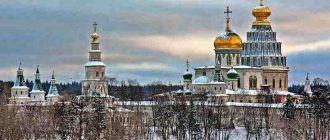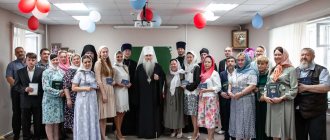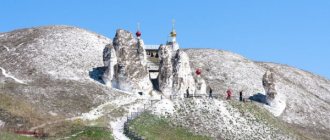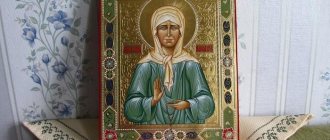| Cathedral of Christ the Savior |
Moscow Diocese
of the Russian Orthodox Church
- Diocesan administration: Russia, 119034, Moscow, Chisty lane, 5
- Official site:
- Tel. (also fax)
- Canonical territory: Moscow (Moscow region belongs to the Moscow Metropolis)
- Cathedrals: Cathedral of Christ the Savior and Elokhovsky Epiphany in Moscow
- On the map: Yandex.Map, Google map
Moscow first became a bishop's see in 1325, when Metropolitan of Kiev and All Rus' St. Peter settled here.
The metropolitans adopted the title of “Moscow” in 1461, in connection with the separation of the Russian Orthodox Church from Constantinople. As a primal see, Moscow became the center of a vast primal region - known as the "Metropolitan," with the establishment of the patriarchate in Rus' in 1589 as the "Patriarchal," and with the suppression of the patriarchate in 1721 as the "Synodal." In the first decades of the Synodal period, Moscow did not have its own bishop, and only on September 1, 1742, the Synodal region was abolished, and instead of it, the Moscow diocese was established in Central Russia as a metropolis. At the same time, the chair of the Moscow diocesan bishop was supposed to be in the Archangel Cathedral, while the Great Assumption Cathedral of the Moscow Kremlin remained “the first throne, the supreme cathedral of Moscow and All-Russia” [1]. On July 16, 1744, the Vladimir and Kostroma dioceses were separated from the Moscow dioceses.
In 1883, the see of the Moscow diocese was moved from the Archangel Cathedral to the Cathedral of Christ the Savior.
| Moscow Epiphany Cathedral in Elokhov |
In 1917, in connection with the restoration of the canonical patriarchal system, Moscow again became the patriarchal capital city, and the Moscow diocese became a patriarchal region, the administration of which, by the authority of the All-Russian Patriarchs, is carried out by patriarchal governors, in the rank of Kolomensky (since 1918), then Krutitsky (since 1919 ).
In the 1920s-1940s, there was a renovation department of the same name.
After the capture of the Cathedral of Christ the Savior by renovationist schismatics, the Patriarchal and Moscow Cathedrals venerated the Church of the Exaltation of the Holy Cross on Vozdvizhenka, then the Church of the Epiphany in Dorogomilovo, then the Church of the Intercession in Krasnoe Selo and, finally, the Church of the Epiphany in Elokhov.
Since 1977, the manager of the Moscow diocese, its ruling bishop (within the boundaries of the Moscow region, with the exception of the city of Moscow) is the Metropolitan of Krutitsky and Kolomna, whose residence is located in the Novodevichy Convent in the city of Moscow.
The Local Council of the Russian Orthodox Church in 1988 adopted a new “Charter on the governance of the Russian Orthodox Church”, according to which: “The Patriarch is the diocesan bishop of the Moscow Diocese. To facilitate the Patriarch in his care of general church affairs, the Moscow diocese is governed at the direction of the Patriarch, with the rights of a diocesan bishop, by the Patriarchal Vicar with the title of Metropolitan of Krutitsky and Kolomna” and is a permanent member of the Holy Synod by department.
The Anniversary Council of Bishops of the Russian Orthodox Church in 2000 adopted a new “Charter of the Russian Orthodox Church”, according to which: “The Patriarch of Moscow and All Rus' is the diocesan bishop of the Moscow diocese, consisting of the city of Moscow and the Moscow region. The Patriarch of Moscow and All Rus' is assisted in the management of the Moscow diocese by the Patriarchal Vicar, with the rights of a diocesan bishop, with the title of Metropolitan of Krutitsky and Kolomna.” The territorial boundaries of the administration exercised by the patriarchal governor, Metropolitan of Krutitsky, with the rights of a diocesan bishop, are determined by the Patriarch of Moscow and All Rus' and now include the Moscow region excluding Moscow.
In view of the expansion and revitalization of church life in the Moscow diocese, suffragan bishops were appointed to assist the patriarch in managing the Moscow diocese at the end of 2010, transferring to them some of the powers of the ruling bishop. On December 27, 2011, it was decided to divide the city of Moscow into 11 local vicariates: Central (Central Administrative District of Moscow); Yuzhnoye (Southern Autonomous Okrug); Yugo-Zapadnoye (South-Western AO); Western (Western AO); North-Western (North-Western and Zelenograd Autonomous Okrug); Severnoye (Northern AO); North-Eastern (North-Eastern AO); Vostochnoye (Eastern AO); South-East (South-East AO); Vicariate for lands planned to be included in Moscow.
In connection with the inclusion of new territories allocated from the Moscow region into Moscow, according to the patriarchal resolution of February 8, 2012, these territories came under the direct subordination of the Patriarch of Moscow and All Rus'.
On April 13, 2022, the Balashikha, Kolomna, Odintsovo, Podolsk and Sergiev Posad dioceses were separated from the Moscow regional diocese with the formation of the Moscow Metropolis on the territory of the Moscow region, as a result of which the Moscow diocese was limited to the territory of Moscow [2].
Historical names
- Kiev and All Russia (Rus, Russia) (1325 - May 3, 1461)
- Moscow and All Russia (Rus, Russia) (May 3, 1461 - September 1, 1742)
- Moscow and Vladimir (September 1, 1742 - March 10, 1748)
- Moscow and Sevskaya (March 10, 1748 - January 13, 1764)
- Moscow and Kaluga (January 13, 1764 - October 16, 1799)
- Moscow and Kolomenskaya (October 16, 1799 - November 21, 1917)
- Moscow (November 21, 1917 - ?)
- Moskovskaya and Kolomenskaya (mentioned 1941 - September 8, 1943)
- Moscow (since September 8, 1943)
Statistics
- January 1, 1958 [3] - 212 registered temples/houses of worship.
- 2006 - in the Moscow diocese there were 724 churches and chapels, including: 2 cathedrals, 5 men's and 4 women's monasteries, 296 parishes and 69 monastery churches, 117 patriarchal and 69 monastic farmsteads, 7 baptismal churches and 69 chapels. Divine services are held in 585 churches and chapels, 122 of which are house chapels. In 16 churches, services have not been resumed, and 34 churches have not been vacated by their previous tenants. Moscow is divided into 14 deaneries - church territorial-administrative districts [4].
- March 20, 2006 - 40 deanery districts, 1032 parishes; in addition to this, 3 parishes of the same faith are directly subordinate to the metropolitan; 1143 clergy (1048 priests, 95 deacons); 21 monasteries and 12 monastic farmsteads (9 men’s with 6 farmsteads, 12 women’s with 6 farmsteads); The educational theological institution of the diocese is Kolomna Theological Seminary
- December 28, 2012 (across the city of Moscow) - 894 churches and chapels (of which 6 Kremlin cathedrals, 2 cathedrals, 18 churches and chapels at synodal institutions, 8 churches at representative offices of the Orthodox Churches, 22 baptismal churches, 79 chapels, 82 churches of patriarchal metochions , 84 monastery churches, 2 monastery chapels, 475 parish churches, 90 churches under construction, 26 temporary churches in the areas where churches are being built under Program 200. 383 churches and prayer rooms where services are held regularly and parish communities exist. 23 churches have not yet been vacated by the previous tenants); the number of clergy over the past year increased by 146 people (arrived: 64 from the Moscow regional diocese, 21 from other dioceses, 43 accepted into the clergy, 18 graduates of theological schools; departure: 4 moved to other dioceses, 3 were banned from the priesthood, 2 were deprived of their rank , 12 died) [5]
- December 20, 2013 (in the city of Moscow) - the total number of churches and chapels is 958, of which: Kremlin cathedrals - 6, cathedrals - 2, churches and chapels at synodal institutions - 18, churches at representative offices of the Orthodox Churches - 12, baptismal churches - 20, parish chapels - 48, churches of the Patriarchal metochions - 95, monastery churches - 44, monastery chapels - 4, parish churches - 278, churches under construction - 142, chapels under construction - 4, gate churches - 5, churches at secular institutions - 164, chapels at secular institutions - 29, monastery farmsteads - 10, temporary churches - 43, temporary chapels - 10, 24 churches have not yet been vacated by the previous tenants. In 2013, 166 clergy arrived (of which 32 were graduates of theological schools, 53 were ordained from the clergy, 39 were accepted from other dioceses, 42 were sent for temporary service in Moscow churches and stavropegic monasteries); loss: 36 (14 moved to other dioceses, 6 were counted among the staff, 7 were banned from the priesthood, 1 was defrocked, 8 people died) [6].
Archpastors
Primate's Department
- See the High Hierarchs of the Kyiv Metropolis of the Orthodox Church of Constantinople, then the Russian Orthodox Church
Moscow diocese
- Joseph (Volchansky) (September 1, 1742 - June 10, 1745)
- Plato I (Malinovsky) (June 10, 1745 - April 14, 1748) v/u, bishop. Krutitsky
- St. Hilarion (Grigorovich) (June 14, 1754 - January 25, 1758) v/u, bishop. Krutitsky
- Ambrose (Zertis-Kamensky) (April 18, 1767 - January 18, 1768) v/u, bishop. Krutitsky
- Gennady (Dranitsyn) (September 16, 1771 - ?) v/u, bishop. Suzdal
- Samuil (Mislavsky) (? - January 20, 1775) v/u, bishop. Krutitsky
- Augustin (Vinogradsky) (June 13, 1811 - February 19, 1818) v/u, Dmitrovsky
- Lavrenty (Bakshevsky) (March 3 - March 15, 1819) v/u, bishop. Dmitrovsky
- Ambrose (Klyucharyov) (March 31 - April 8, 1879, June 9 - 27, 1882) v/u, bishop. Dmitrovsky
- Ambrose (Klyucharyov) (June 9 - 27, 1882) v/u, bishop. Dmitrovsky
- Alexander (Svetlakov) (August 1 - 9, 1893) v/u, bishop. Dmitrovsky
- Tryfon (Prince Turkestan) (April 26 - June 26, 1910) high school, bishop. Dmitrovsky
- Vasily (Preobrazhensky) (November 1912 - December 23, 1912) high school, bishop. Mozhaisky
- Tryfon (Prince Turkestan) (June 1 - September 1, 1914) v/u, bishop. Dmitrovsky
- Joasaph (Kalistov) (March 20 - June 21, 1917) v/u, bishop. Dmitrovsky
Primate's Department
- See Primates of the Russian Orthodox Church
- Alexy (Gotovtsev) (February - May 1926) high school bishop. Serpukhovsky
- Seraphim (Silichev) (August 28, 1926 - July 1927) v/u, bishop. Podolsky
Governors of the diocese with the exception of the city of Moscow
- Since June 11, 1977 - see the Eminences of the Krutitsa diocese
Amazing things are happening in the Moscow diocese
About Metropolitan Juvenalia
Amazing things are happening in the Moscow diocese, headed by Metropolitan Juvenaly (Poyarkov) of Krutitsky and Kolomna, who turns 84 this year. Metropolitan Yuvenaly is even more fierce than at the beginning of his ministry at the Krutitsa See and even more than during the time of Alexy II. Bans priests for any reason; a report from the dean, who did not share something with his rector or cleric, is enough - and the sentence is passed immediately.
Today in the Moscow diocese there are 165 priests banned from serving, with a total number of clergy of 1554, that is, more than every tenth priest! There are also a lot of supernumerary ones - 113 clergy, of which only 17 have reached the age of 75, while in the Moscow city diocese, with 1685 clergy, the number of banned priests is such an insignificant percentage that it’s not worth talking about.
What is the matter, maybe in the Moscow (regional) diocese there is such a clergy that only constant repression can keep in obedience the priests entrusted to Metropolitan Juvenal, who leads his diocese from the Domodedovo hospital, who constantly violate their oath and apostolic rules? However, in the constant transfers, bans, petitions for the staff, the main tendency of Metropolitan Juvenaly can be traced, presumably directly propagated by him to his dean - this is the replacement of venerable, respected pastors - rectors of churches with young graduates of the Kolomna Seminary and those transferred from other dioceses.
Why did those priests who organize parish life and lead a permanent Orthodox mission not please Metropolitan Juvenaly? The fact that they are champions of Orthodoxy, preventing modernist tendencies, directly related to the Catholic and ecumenical position of Metropolitan Juvenal himself, from entering the Church. The young chicks of the nest of Bishop Konstantin of Zaraisk or PSTGU V. Vorobyov, thoroughly imbued with the teachings of Origen and the need to introduce modernism into the Russian Orthodox Church, are ready not only to fulfill any whim of the dean and ruling bishop, but often go further, directly deviating into the Catholic heresy.
What remains for the banned and unemployed priests, many of whom have large families? To deviate into one’s own personal schism – to go to other churches, including the OCU, to join the ranks of the Old Believers, or even to transform into a sect. Thus, by thoughtlessly replacing experienced pastors, who have worked hard in the field of the Orthodox faith, with beardless youths, colossal damage is caused to the Church, when the spiritual children of a banned/supernumerary/demoted priest, transferred to a remote place, disperse in all directions, but the majority simply leaves the Church, cursing her hierarchy and seducing others to never visit the House of God again.
That is why the number of parishioners decreases from year to year, services are not ordered, funeral services are not performed for the dead, and crowns are not placed on the heads of those being married. We urgently need to change this sad situation, otherwise the Church will become impoverished without people, churches will close, and we will get today's Europe without Jesus Christ, with closed and destroyed churches, with the removal of crucifixes from hospitals, schools and government institutions, with a ban on wearing crosses and the replacement of Christian holidays to social parties with same-sex “family”.
The main reason is money IMHO. A rich diocese, the population is not poor (for the most part). There are not many temples for such a territory and the number of people. There are many who want to serve. Five seminaries (in Posad in Kolomna in Ugresh, Sretenskaya and Perervinskaya in Moscow), MDA, two theological universities (PSTGU and Ros Prav University), Orthodox graduate school in Novospassky and. etc. I know that there was a theological faculty in one of the commercial universities. Large annual releases.
Imagine the scale! There is an overabundance of personnel, unlike most other dioceses. “Getting through” is very, very difficult. Nobody wants to go to neighboring regions (financially everything is much worse there). So what happens is that places are bought and sold + relatives, children of the clergy themselves through connections. Hence the frequent transfers from place to place to free up space for the one who brought it and frequent prohibitions (there are few churches, there are many who want to stand at the altar). Why stand on ceremony when there are 10 people willing to take his place instead of the one who left?
Vicar dioceses
- Vicariates of Moscow
- Central
- South
- Southwestern
- Western
- Northwestern
- Northern
- Northeast
- Eastern
- Southeast
- New territories of Moscow
- Balashikha (now independent)
- Bogorodskaya (inactive)
- Bronnitskaya
- Vereiskaya
- Vidnovskaya
- Vladimirskaya (now independent)
- Volokolamsk
- Voskresenskaya
- Vyshegorodskaya (inactive)
- Dmitrovskaya (inactive)
- Domodedovo
- Dubninskaya
- Egoryevskaya
- Zaraiskaya
- Zvenigorodskaya
- Zelenogradskaya
- Istra
- Kashirskaya
- Klinskaya
- Kolomenskaya (now independent)
- Krasnogorskaya (inactive)
- Krutitskaya
- Lukhovitskaya
- Lyuberetskaya (inactive)
- Mozhaiskaya
- Mytishchi
- Naro-Fominsk
- Noginskaya (see Bogorodskaya) (inactive)
- Odintsovskaya (now independent)
- Ozerskaya
- Orekhovo-Zuevskaya (inactive)
- Pavlovo-Posadskaya (inactive)
- Podolskaya (now independent)
- Ramenskaya
- Ruzskaya
- Sevskaya (now Orlovskaya (now independent)
- Sergiev Posad (now independent)
- Sergievskaya (inactive)
- Serpukhovskaya
- Solnechnogorsk
- Trinity
- Shaturskaya (inactive)
Diocesan Council
Composition of the Diocesan Council of Moscow
Members of the Diocesan Council appointed by His Holiness the Patriarch:
- Metropolitan Dionysius of the Resurrection, first vicar of the Patriarch of Moscow and All Rus' for Moscow, manager of the Central Vicariate
- Metropolitan Theognostus of Kashira, Administrator of the Vicariate of the New Territories
- Archbishop Matthew of Yegoryevsk, Administrator of the North-Eastern and South-Eastern Vicariates
- Bishop Panteleimon of Verean, Administrator of the Eastern Vicariate
- Bishop Paramon of Naro-Fominsk, Administrator of the Northern and Northwestern Vicariates
- Bishop Thomas of Sergiev Posad and Dmitrov, Administrator of the Southern Vicariate
- Bishop Thomas of Odintsovo and Krasnogorsk, administrator of the Western Vicariate
- Protopresbyter Vladimir Divakov, Secretary of the Patriarch of Moscow and All Rus' for Moscow - Secretary
- Archpriest Kirill Shevtsov - secretary
Members of the Diocesan Council elected by the Diocesan Assembly:
- Archpriest Mikhail Ryazantsev (Central Vicariate)
- Archpriest Sergius Dikiy (Northern Vicariate)
- Archpriest Georgy Klimov (North-Eastern Vicariate)
- Archpriest Alexy Batanogov (Eastern Vicariate)
- Archimandrite Alexy (Vylazhanin) (South-Eastern Vicariate)
- Archpriest Alexander Farkovets (Southern Vicariate)
- Archpriest Viktor Alipichev (South-Western Vicariate)
- Archpriest Seraphim Nedosekin (Western Vicariate)
- Priest Andrey Shumkin (North-Western Vicariate)
- Archpriest Sergius Gudanov (vicariate of New Territories)
***
Departments and commissions under the Diocesan Council of Moscow
***
According to the Statute of the Russian Orthodox Church, the Diocesan Council, headed by the diocesan bishop, is the governing body of the diocese.
The diocesan council is formed with the blessing of the diocesan bishop and consists of at least four persons in the priestly rank, half of whom are appointed by the bishop, and the rest are elected by the Diocesan Assembly for three years.
If members of the Diocesan Council violate the doctrinal, canonical or moral norms of the Orthodox Church, as well as if they are under ecclesiastical court or investigation, they are removed from their positions by decision of the diocesan bishop.
The Chairman of the Diocesan Council is the diocesan bishop, for the city of Moscow this is His Holiness the Patriarch of Moscow and All Rus'.
The Diocesan Council meets regularly, but at least once every six months. The quorum of the Diocesan Council is a majority of its members. The Diocesan Council works on the basis of an agenda presented by the chairman. The chairman presides over the meeting in accordance with the adopted rules.
The bishop appoints the secretary of the Diocesan Council from among its members. The secretary is responsible for preparing materials necessary for the council and compiling minutes of meetings. If disagreements arise during the consideration of a case, the case is resolved by a majority vote; In case of equality of votes, the chairman's vote has the upper hand. The journals of the meetings of the Diocesan Council are signed by all its members.
The Diocesan Council, in accordance with the instructions of the diocesan bishop:
- carries out decisions of the Diocesan Assembly that fall under the jurisdiction of the council, reports to it on the work done;
- establishes the procedure for electing members of the Diocesan Assembly;
- prepares meetings of the Diocesan Assembly, including proposals for the agenda;
- submits its annual reports to the Diocesan Assembly;
- considers issues related to the opening of parishes, deaneries, monasteries, production and economic activities, governing bodies and other divisions of the diocese;
- takes care of finding funds to satisfy the material needs of the diocese, and, if necessary, parishes;
- determines the boundaries of deaneries and parishes;
- reviews the reports of deans and makes appropriate decisions on them;
- oversees the activities of Parish Councils;
- considers plans for the construction, major repairs and restoration of churches;
- keeps records and takes measures for the safety of the property of the Russian Orthodox Church: churches, houses of worship, chapels, monasteries, Theological educational institutions and other divisions of the diocese, as well as the property of the diocese;
- within the limits of its competence, resolves issues related to the ownership, use and disposal of the property of parishes, monasteries and other canonical units of the diocese; real estate of canonical units included in the diocese, namely buildings, structures, land plots, can be alienated only on the basis of a decision of the Diocesan Council;
- carries out an audit of diocesan institutions;
- takes care of provision for casual clergy and church workers;
- discusses preparatory activities for anniversaries, general diocesan celebrations and other important events;
- resolves any other matters that the diocesan bishop sends to the Diocesan Council for their decision or for study in order to provide it with the necessary recommendations;
- examines issues of liturgical practice and church discipline.
By order of His Holiness Patriarch Kirill dated December 31, 2011, the managers of the diocesan vicariates of Moscow were included in the Diocesan Council of Moscow ex officio.
Monasteries
The following stauropegial monasteries are located within the diocese:
- Moskovsky Alekseevsky (female)
- Moscow Andreevsky (male)
- Moscow Theotokos-Nativity (women's)
- Moscow Vysokopetrovsky (male)
- Moskovsky Danilov (male)
- Moscow Donskoy (male)
- Moskovsky Zaikonospassky (male)
- Moscow Zachatievsky (female)
- Moscow Ioanno-Predtechensky (female)
- Moscow Novodevichy (female)
- Moskovsky Novospassky (male)
- Moskovsky Pokrovsky (women's)
- Moscow Sretensky (male)
- Trinity-Odigitrievskaya Zosimova Hermitage (women's)
Inactive monasteries:
- Moscow Epiphany (closed 1918)
- Moscow Znamensky (closed in 1929)
- Moscow Holy Cross (established in 1814)
- Moscow Simonov (closed in the 1920s)
- Moskovsky Strastnoy (closed in 1919, demolished in 1937)
- Moscow Chudov (closed in 1919, demolished in 1930)
Story
The history of the capital's diocese is directly related to the development of the All-Russian metropolitans' own possessions. Moscow became the permanent residence of the head of the Russian Church in 1325. His possessions included Moscow, Vladimir, Nizhny Novgorod and more than 10 other cities located in the center of the Russian plain.
Gradually the possessions grew, and in order to manage them it became necessary to transfer part of the bishop's responsibilities to an assistant. For some time this duty was performed by the bishops of Kolomna.
After the see of the Sarai diocese was moved to the Moscow region and placed in Krutitsy, Bishop Krutitsy received the status of vicar of the Moscow bishop. After its establishment at the end of the 16th century. Russian Patriarchate, the deputy of the patriarch received the title of Metropolitan of Krutitsky.
The Cathedral of Christ the Savior is the cathedral of Moscow
At the beginning of the 18th century, the vast estates of the church rulers came under the control of the Synod. For 40 years the diocese did not have an official bishop and was headed by Bishop Krutitsky. A separate Moscow diocese was established in 1742 at the behest of Empress Elizabeth Petrovna. It included vast territories belonging to the Moscow, Tambov, Belgorod, Voronezh, Kazan, Novgorod and Arkhangelsk provinces.
During the second half of the 18th century. The patriarchal see underwent many territorial and administrative changes. One of the most active heads of the diocese was Metropolitan Platon Levshin. Under him, the Slavic-Greek-Latin Academy and about a dozen monasteries came under Moscow jurisdiction.
Interesting! The bishop established the regular work of the diocesan administration and paid great attention to the organization of theological schools. Metropolitan Plato was also the author of many sermons, akathists and theological works.
In 1917, with the revival of the Russian Patriarchate, the status of the patriarchal region was also restored. By decree of Patriarch Tikhon, Iosaf was appointed its manager, who received the title of Archbishop of Kolomna and Krutitsky. The persecution of the church, which began with the Bolsheviks coming to power in the country, complicated the situation of the clergy.
In the 20-40s. At the same time as the canonical diocese, there was a renovation department. Due to repressions until the early 40s. The leaders of the patriarchal estates changed frequently.
Since 1945, the metropolitans of Krutitsky were officially assigned the functions of administrators of the Moscow diocese. In the second half of the 20th century. The following clergy were the vicars of the patriarch:
- Nikolai Yarushevich;
- Pitirim Svirodov;
- Seraphim Nikitin;
- Yuvenaly Poyarkov.
Metropolitan Yuvenaly has been the Metropolitan of Krutitsky to this day. The Bishop accepted a small diocese, in which there was no monastic life and 132 parishes functioned. Currently, the diocese includes 493 parishes, 33 monastic communities with a total number of inhabitants of about 2,000 people. Active temple construction is underway in the capital and region.
Patriarch of Moscow and All Rus' Kirill - head of the Moscow diocese
Currently, the Moscow diocese consists of two virtually independent parts, which have an independent management structure. Its head is the Patriarch of Moscow and All Rus', and the Metropolitan of Krutitsky and Kolomna helps him in managing his vast domains.
